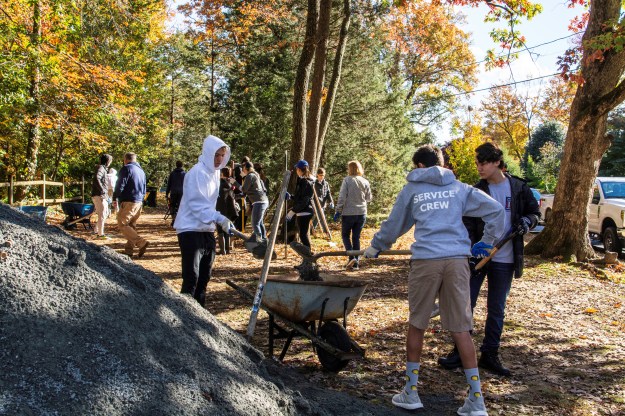Despite its role in protecting the capital from Confederate attack during the Civil War, lately Fort Willard has been unable to protect itself from a different sort of invasion: invasive overgrowth.
 After the unexpected Confederate victory at the Battle of Manassas in July 1861, concern for the safety of the District of Columbia and Alexandria prompted plans for a complete fortification system for Washington. Construction began immediately, and there were 60 forts and 93 batteries protecting the city by the end of 1863. Greater emphasis was placed on the southern forts because they were believed to be in more danger of attack.
After the unexpected Confederate victory at the Battle of Manassas in July 1861, concern for the safety of the District of Columbia and Alexandria prompted plans for a complete fortification system for Washington. Construction began immediately, and there were 60 forts and 93 batteries protecting the city by the end of 1863. Greater emphasis was placed on the southern forts because they were believed to be in more danger of attack.
Fort Willard, the southernmost fortification in the Defenses of Washington, is located on a high point of a ridge overlooking low ground along the Potomac River. It commands a clear view to present day Fort Hunt Road and beyond. Constructed at the end of 1862 as Redoubt “D” to Fort Lyon by detachments of the 34th Massachusetts Infantry, it was later named in honor of Colonel George L. Willard, who was killed at Gettysburg on July 2, 1863.
After the Civil War, the site most likely lay fallow for many years. In the 1930s, development of the Belle Haven subdivision began, and the fort site was preserved in an area that eventually became Fort Willard Circle. Today you can still see the earthen fortifications, cannon embrasures or platforms, and the remains of a bombproof (bomb shelter) and magazine (arms and gunpowder storage) area. The relative isolation of this site within a quiet residential neighborhood has allowed for the archaeological and cultural features at Fort Willard Historic Site to remain relatively undisturbed and subject only to the natural processes of erosion and tree growth.
 This overgrowth did not intimidate the members of the Young Men’s Service League (YMSL) of Vienna-Oakton, a volunteer organization comprised of mothers and their high school-aged sons with a mission to serve the community and develop leadership skills. One hundred and fourteen members, divided into morning and afternoon shifts, volunteered a Saturday to refresh Fort Willard Park.
This overgrowth did not intimidate the members of the Young Men’s Service League (YMSL) of Vienna-Oakton, a volunteer organization comprised of mothers and their high school-aged sons with a mission to serve the community and develop leadership skills. One hundred and fourteen members, divided into morning and afternoon shifts, volunteered a Saturday to refresh Fort Willard Park.
The group completed three assigned projects — regrading and extending the park’s perimeter path, removing overgrowth from the perimeter fence, and cleaning the community’s brick gathering areas.
The perimeter path, only present on the southeast half of the circle, lost much of its gravel and stone dust over the years and was in need of a fresh layer. The goal also was to extend the path through an area typically plagued with mud and standing water. Following a full day of work regrading and extending the perimeter path, neighbors and visitors now can navigate the entire border of the Civil War fort without encountering mud and flooded areas.
Perimeter path before and after.
The perimeter fence was overrun by wisteria, English ivy, Virginia creeper, pokeweed and thorny brambles. Moss dominated the brick gathering spaces. Clearing the overgrowth along the fence line allowed for a better view of the earthworks, and the clean brick plaza areas will make wonderful backdrops for community gatherings.
Brick area and perimeter path before and after.
Project leaders included nine Park Authority staff and three members of the Belle Haven Citizen’s Association. During the lunch break, David Buchta and Elizabeth Crowell of the Park Authority spoke to the volunteers about the historical and archaeological significance of Fort Willard.

The Vienna-Oakton Chapter of the Young Men’s Service League.
The Young Men’s Service League provides young men with important skills and experiences to guide their futures and creates an environment for mothers and their sons to bond. The Park Authority was fortunate to encounter this organization, and Fort Willard’s efforts offer an example of enhancing stewardship of the county’s cultural resources on parkland.
Author Margaret Publisi Canilang is a Heritage Resource Technician for the Fairfax County Park Authority’s Resource Management Division.








